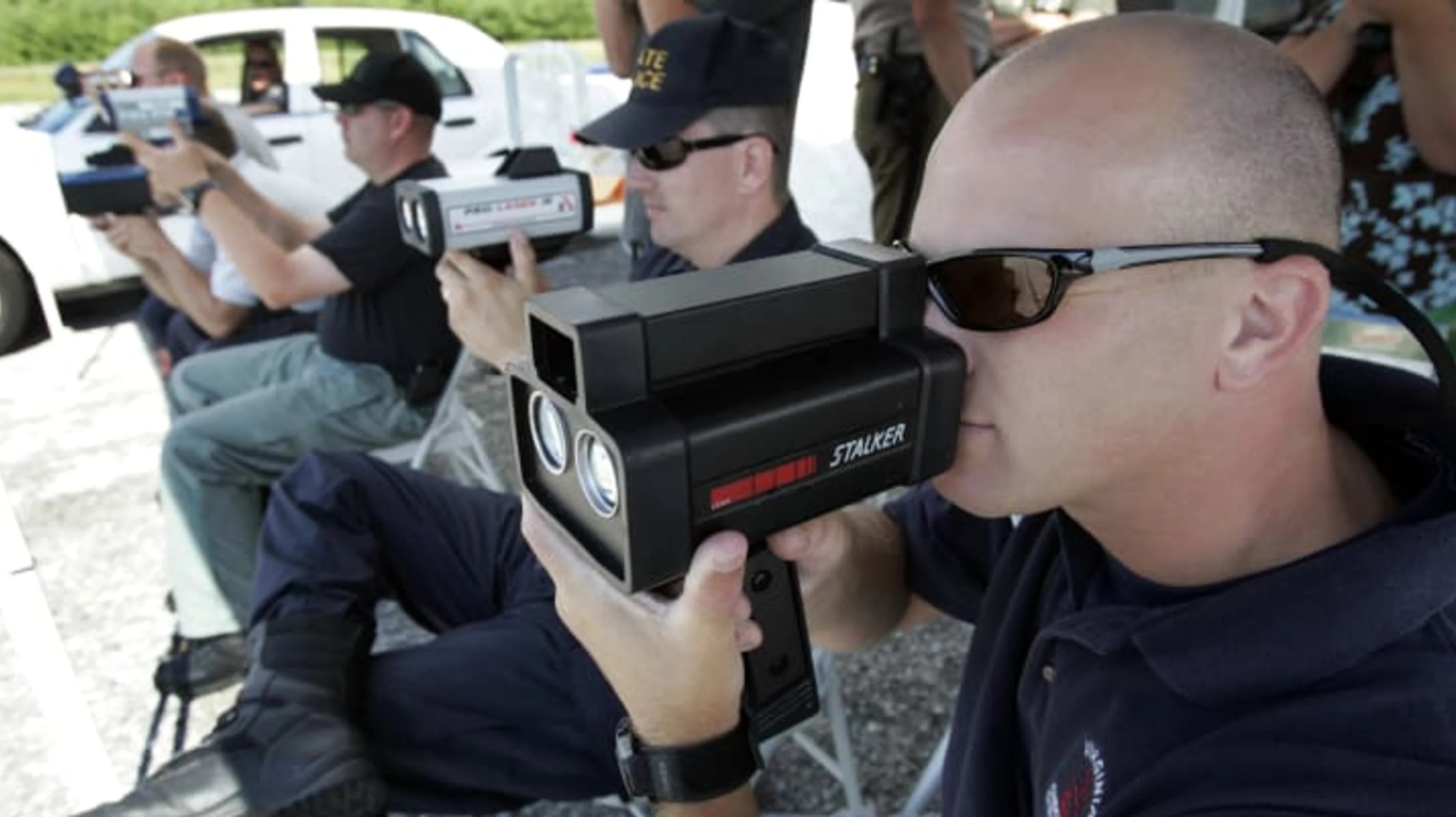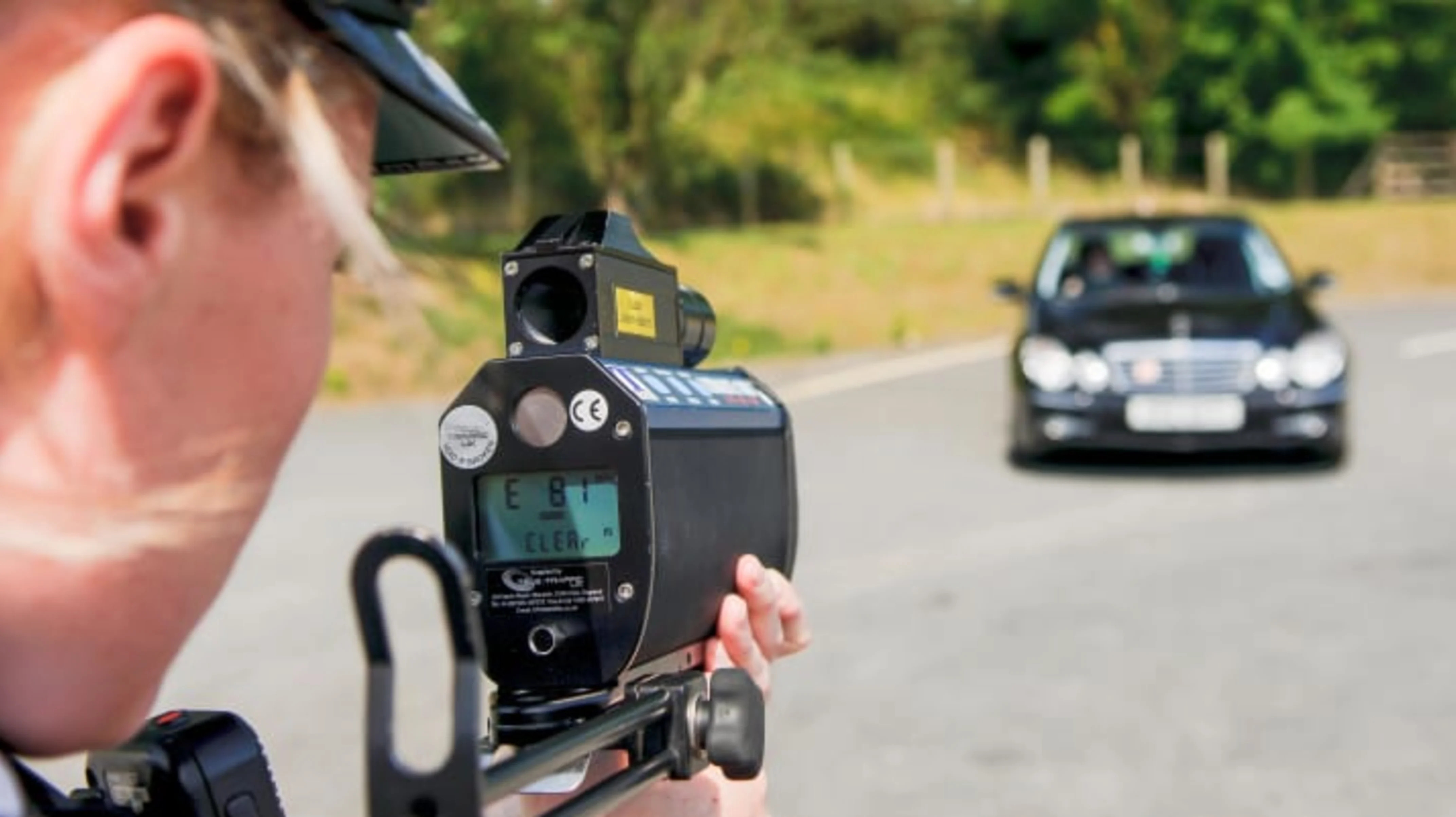You're driving down the road, minding your own business, and suddenly you spot an officer parked on the side of the road pointing something at your car that looks like a radar gun. Your trusty radar detector never makes a peep, though. The first thoughts that race through your mind: Is my detector broken or did the cops get some new radar gun that my detector can't detect?
Chances are the answer to both questions is no. What happened is that you were shot with a police laser gun. You can defend yourself in this situation, so read on.
How Does a Police Laser Gun Work?
Unlike a police radar gun, which shoots a radio signal, a laser gun transmits a narrow beam of invisible light in the near-infrared spectrum. Once an officer selects a car to target, he will take aim through the crosshairs of his laser gun, aiming at the most reflective areas, typically the front plate or a headlight. As he pulls the trigger, this invisible beam of light is transmitted from the gun and reflected back; based on how long it takes to go and return, the gun instantaneously calculates and tells the officer the target vehicle's speed and distance.
If your car is equipped with a radar detector with laser detection capabilities, chances are it may never alert because this beam of light is only 18 inches wide at 500 feet. And if it does go off, just pull over, because "once you're shot, you're got." Unless, of course, your car is equipped with a laser jammer.

How Popular are Police Laser Guns?
Nationwide, police laser accounts for over 25 percent of the 125,000 speeding citations issued each day. However in Ohio, Florida, and Rhode Island, laser accounts for over half the speeding citations. With the exception of a few radar guns on military bases, the state of Hawaii has transitioned to using laser exclusively.
One reason for the increasing popularity of police laser enforcement is that auto insurance companies are donating laser guns to police departments. Laser is much more difficult to defeat than radar guns, and this investment pays back the insurance company dividends because of the increased revenue raised through higher insurance premiums.
How Does a Laser Jammer Work?
The earliest laser jammers worked on a simple principle of brute force to overpower the police laser gun by reflecting back a brighter beam of light. As laser jamming devices started taking hold, the laser gun manufacturers began fighting back by integrating variable and random pulse rates into the transmitted beam of light.
Because of this, laser jammer manufacturers today must source all the different makes, models, and versions of the laser guns used by law enforcement to program database look-up tables and jamming code sequences to defeat each of them. The result is a sophisticated device designed to confuse the laser gun into giving an unusable reading.

Where Do You Mount a Laser Jammer?
Laser enforcement is typically done as you're approaching an officer who's targeting a headlight or front plate. Because of this, the laser jammer transceivers must be mounted in the grille area of your vehicle to be effective.
These transceivers then interface with a controller mounted under the dash, which then interfaces with an external warning LED and/or speaker. The number of transceivers needed depends on the size of your vehicle. For example, a mid-sized car would require two heads, while larger SUVs would require at least three.
Rear laser enforcement accounts for only 5 percent of all speeding tickets, but in some areas, such as Dallas/Fort Worth, police are well known to target the rear of vehicles from overpasses and highway entrance ramps. The rear of a vehicle can also be protected, but it can be more difficult to mount heads there and will increase cost.
Are Laser Jammers Legal?
The Food and Drug Administration regulates laser and currently there are no federal laws regulating laser-jamming devices in passenger cars. However, the states of California, Colorado, Illinois, Minnesota, Nebraska, Oklahoma, South Carolina, Tennessee, Texas, Utah, and Virginia as well as the District of Columbia have enacted their own laws prohibiting their use. Because of this, some laser jamming manufacturers have integrated methods to transform a laser-jamming device into a parking-assist sensor after transmitting its jamming code sequence to avoid suspicion.

How Much Will a Laser Jammer Cost Me?
For a typical mid-sized passenger car, a good laser jamming system starts off around $600. Before you do decide to make the investment, however, there are two important things to research: How often does the jammer manufacturer offer updates to its firmware? And what is the jammer's ability to jam the new pulse-rate and random-pulse-rate laser guns, such as the DragonEye?
Roy Reyer operates RadarBusters.com. Visit the site for more information about laser jammers, how they work, and in-depth ratings.
Chances are the answer to both questions is no. What happened is that you were shot with a police laser gun. You can defend yourself in this situation, so read on.
How Does a Police Laser Gun Work?
Unlike a police radar gun, which shoots a radio signal, a laser gun transmits a narrow beam of invisible light in the near-infrared spectrum. Once an officer selects a car to target, he will take aim through the crosshairs of his laser gun, aiming at the most reflective areas, typically the front plate or a headlight. As he pulls the trigger, this invisible beam of light is transmitted from the gun and reflected back; based on how long it takes to go and return, the gun instantaneously calculates and tells the officer the target vehicle's speed and distance.
If your car is equipped with a radar detector with laser detection capabilities, chances are it may never alert because this beam of light is only 18 inches wide at 500 feet. And if it does go off, just pull over, because "once you're shot, you're got." Unless, of course, your car is equipped with a laser jammer.

How Popular are Police Laser Guns?
Nationwide, police laser accounts for over 25 percent of the 125,000 speeding citations issued each day. However in Ohio, Florida, and Rhode Island, laser accounts for over half the speeding citations. With the exception of a few radar guns on military bases, the state of Hawaii has transitioned to using laser exclusively.
One reason for the increasing popularity of police laser enforcement is that auto insurance companies are donating laser guns to police departments. Laser is much more difficult to defeat than radar guns, and this investment pays back the insurance company dividends because of the increased revenue raised through higher insurance premiums.
How Does a Laser Jammer Work?
The earliest laser jammers worked on a simple principle of brute force to overpower the police laser gun by reflecting back a brighter beam of light. As laser jamming devices started taking hold, the laser gun manufacturers began fighting back by integrating variable and random pulse rates into the transmitted beam of light.
Because of this, laser jammer manufacturers today must source all the different makes, models, and versions of the laser guns used by law enforcement to program database look-up tables and jamming code sequences to defeat each of them. The result is a sophisticated device designed to confuse the laser gun into giving an unusable reading.

Where Do You Mount a Laser Jammer?
Laser enforcement is typically done as you're approaching an officer who's targeting a headlight or front plate. Because of this, the laser jammer transceivers must be mounted in the grille area of your vehicle to be effective.
These transceivers then interface with a controller mounted under the dash, which then interfaces with an external warning LED and/or speaker. The number of transceivers needed depends on the size of your vehicle. For example, a mid-sized car would require two heads, while larger SUVs would require at least three.
Rear laser enforcement accounts for only 5 percent of all speeding tickets, but in some areas, such as Dallas/Fort Worth, police are well known to target the rear of vehicles from overpasses and highway entrance ramps. The rear of a vehicle can also be protected, but it can be more difficult to mount heads there and will increase cost.
Are Laser Jammers Legal?
The Food and Drug Administration regulates laser and currently there are no federal laws regulating laser-jamming devices in passenger cars. However, the states of California, Colorado, Illinois, Minnesota, Nebraska, Oklahoma, South Carolina, Tennessee, Texas, Utah, and Virginia as well as the District of Columbia have enacted their own laws prohibiting their use. Because of this, some laser jamming manufacturers have integrated methods to transform a laser-jamming device into a parking-assist sensor after transmitting its jamming code sequence to avoid suspicion.

How Much Will a Laser Jammer Cost Me?
For a typical mid-sized passenger car, a good laser jamming system starts off around $600. Before you do decide to make the investment, however, there are two important things to research: How often does the jammer manufacturer offer updates to its firmware? And what is the jammer's ability to jam the new pulse-rate and random-pulse-rate laser guns, such as the DragonEye?
Roy Reyer operates RadarBusters.com. Visit the site for more information about laser jammers, how they work, and in-depth ratings.


Sign in to post
Please sign in to leave a comment.
Continue